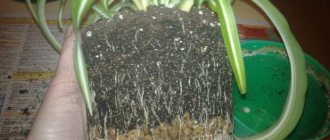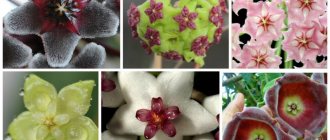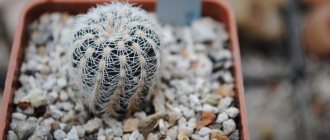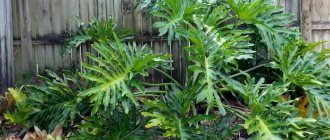The main decoration of the plant is lush emerald greenery: the leaves of scindapsus are large, leathery, heart-shaped, and in some varieties they are covered with a marble pattern of various shades of white and yellow. The scindapsus flower is not particularly remarkable; it is a small spadix wrapped in a “veil” of a greenish-whitish hue.
Also see how to grow indoor Homalomena and Monstera.
| They have a high development rate - they add up to 45 cm per year. |
| Does not bloom indoors. |
| The plant is easy to grow indoors. |
| Perennial. |
Useful properties of scindapsus
Scindapsus aureus. Photo
Scindapsus painted.
Photo Scindapsus perfectly filters the air in the room where it is located, absorbing most harmful impurities (even toxic compounds of formaldehyde and benzene). Eastern teachings also attribute to the plant the ability to accumulate and redistribute vital energy in the right way, to have a beneficial effect on a person’s mental and physical health, and to maintain the good spirits and optimism of its owner.
Scindapsus: care at home. Briefly
| Temperature | Room temperature in summer (+18-+24°C), low temperature in winter (+13-+16°C). |
| Air humidity | Increased, requires regular spraying. |
| Lighting | Moderate diffused, partial shade is suitable. |
| Watering | Moderate with short periods of soil drying to approximately 2/3 depth. |
| Soil for scindapsus | Any loose nutritious soil. The plant is well suited to a mixture of garden soil, peat and sand, taken in equal proportions. |
| Feeding and fertilizer | From spring to autumn, once every 2-3 weeks, apply liquid fertilizer for indoor plants. |
| Transplantation of scindapsus | Annually for young plants, once every 2-3 years for mature, well-developed bushes. |
| Reproduction | By seeds, cuttings or air layering. |
| Features of cultivation | Scindapsus can be grown at home on a support - a long pole covered with moss. To maintain a neat shape and decorative appearance, it is recommended to regularly subject the plant to formative pruning. |
general information
Scindapsus is a spectacular green vine with all its characteristic features. It is often confused with ivy and is readily grown in apartments and offices. Scindapsus fills the room with a feeling of comfort and perfectly purifies the air.
In nature, the vine grows much larger and clings to trees. At home, she needs supports in the same way, but she will grow much smaller. Long stems up to 2-3 m are densely covered with large leaves. Most often they are not monochromatic - with stains, strokes and patterns.
Photo: domashniecvety.ru
Scindapsus: care at home. Details
Bloom
The scindapus plant blooms extremely rarely at home. In the natural habitat, small, inconspicuous flowers-cobs regularly appear from the axils of the shoots, wrapped in “spreads” of whitish or greenish shades.
Temperature
During the period of active growth, it is recommended to keep scindapsus in a room with an air temperature of about +20°C; in winter, the plant requires moderate coolness - about +15°C.
Spraying
The plant is moisture-loving and does not tolerate dry air in city apartments, so it is recommended to spray it regularly: in the summer at least 3 times a week (preferably daily), in the winter - as needed.
In addition, it is useful to periodically wipe scindapsus leaves with a damp soft cloth to remove dirt and dust.
Lighting
At home, Scindapsus prefers moderate diffused lighting, so eastern or western windows are best suited for its maintenance. The plant can easily adapt to life in partial shade, but in this case the leaves become smaller and their color becomes less saturated.
Watering scindapsus
Water the plant regularly and moderately (once every 4-5 days in summer, once every 7-10 days in winter), avoiding stagnation of moisture in the soil. Water for irrigation is taken at room temperature; after watering, be sure to pour out excess liquid from the pan so as not to provoke rotting of the roots and infection of the plant with fungal diseases.
Pot for scindapsus
Scindapsus should be planted in a medium-sized container of shallow depth. The plant grows its root system quite quickly, but in a pot that is too spacious it does not feel particularly good, it can get sick and even die.
Another requirement for the pot is the presence of a drainage hole to remove excess moisture from the roots.
Priming
Light, moisture- and breathable soil is selected for the plant. Scindapsus can be grown in purchased soil intended for ornamental leafy plants, or in a self-prepared substrate of leaf and turf soil with the addition of peat and sand (all ingredients are taken in equal proportions).
Feeding and fertilizer
During the period of active growth, scindapsus is fed every 2-3 weeks with any liquid fertilizer for ornamental leaf plants. Feeding is temporarily stopped if at the end of autumn the flower goes into a dormant state.
In cases where scindapsus continues to grow without rest in winter, it is fed once a month during this period.
Transfer
Young plants develop very quickly, so they are replanted every year until they are 3 years old. Transplantation of scindapsus at a more mature age can be carried out less frequently - as the root system of the flower grows. For old specimens, it is enough to update the top layer of soil in the pot once every 2-3 years.
Trimming scindapsus
Without proper attention, the plant grows very strongly, and over time its shoots stretch out and lose their decorative properties, so caring for scindapsus at home must necessarily include regular formative pruning. It is carried out every spring, shortening all adult stems by about half their length.
Rest period
Homemade scindapsus does not have a clearly defined dormant period, but its most active growth occurs from early spring to mid-autumn. In other months, the plant slows down in development, so it is temporarily stopped feeding and watered very moderately, avoiding waterlogging of the soil, so as not to provoke the appearance of rot.
Propagation by cuttings
There are two possible methods - dividing the main shoot into parts and cutting the apical part. Cuttings are best done in the spring, but can be done at any season of the year if necessary. Apical cuttings with 2-3 leaves are used. You can divide the shoot into separate parts; one leaf is enough for each piece of stem.
The cuttings are cut with a sharp knife; the cut must be made at an angle; roots are formed directly in this place.
To prevent rotting, you can briefly soak the cuttings in a fresh solution of potassium permanganate. You can root the shoots in water or in moist soil; roots will definitely appear in any case. In this case, it is advisable to treat the cut with a root formation stimulator or phytohormones.
Growing scindapsus from seeds
It is problematic to obtain your own seeds from the plant, because it does not bloom under indoor growing conditions, so scindapsus is propagated using purchased seed material. Seeds are sown in pre-prepared light, loose soil and lightly sprinkled with soil.
In a greenhouse under glass or film, the seeds germinate within several weeks. With the emergence of seedlings, the shelter is removed, and the container with the crops is taken to a well-lit place. After a few more weeks, the strengthened seedlings are planted into separate pots.
Pruning as a way to get shoots
Scindapsus quickly grows to impressive sizes, so its growth can be regulated by periodic pruning. To add fullness to the long stems, the plant needs to be pinched from time to time. To have a constantly healthy and beautiful plant, you can rejuvenate it after a few years by growing new shoots from cuttings. To produce new shoots, the main stem must be cut just above the attachment of any leaf to the stem, in which case a new shoot will emerge from the nearest growing point pointing in a different direction.
Diseases and pests
Scindapsus practically does not create problems for its owner during the growth process, but it reacts painfully to gross and systematic errors in care, which manifests itself in a deterioration in its appearance:
- Scindapsus leaves turn yellow when nutrients in the soil are depleted. The plant should be fed regularly during the active growing season.
- Brown spots on the leaves indicate low humidity in the room. The problem can be solved by regularly spraying the plant and periodically wiping its foliage with a damp soft cloth.
- The tips of scindapsus leaves also curl due to the dry air in the room where the flower is located. Spraying helps increase humidity.
- Black edges of the leaves are a sign that the plant is “freezing” and is too wet. It is necessary to adjust the temperature and watering mode.
- Pale and small leaves of scindapsus appear in poor lighting; the plant loves bright, diffused light, so it is better to place the pot with it on bright eastern or western windows.
- The stem has stretched out - also a sign of a lack of light; the plant needs to be moved from the shadows to a more illuminated part of the room.
- The leaves of scindapsus turn pale under the influence of too bright sun, from the direct rays of which the plant must be shaded.
- Brown tips on scindapsus leaves usually appear if the flower is near a source of artificial heat. It is better not to place a pot with scindapsusosm near a radiator or heater, but if no other place can be found for it, the plant should be regularly wiped and sprayed.
There are few pests that pose a danger to scindapsus; these include mealybugs, spider mites, aphids and scale insects. Modern insecticides cope well with them.
Types of scindapsus domestica with photos and names
Epipremnum pinnatum
A spectacular ampelous variety with very long flexible shoots and beautiful leathery heart-shaped leaves, painted in a lush green color with a golden marble pattern over the entire surface. When grown indoors, it blooms extremely rarely with an inconspicuous flower-cob surrounded by a narrow greenish “veil.”
Scindapsus aureum (Epipremnum aureum)
A widespread species in indoor floriculture with long stems and large glossy dark green leaves with a beautiful pattern of golden-yellow spots and stripes across the entire surface of the leaf blades.
Spotted or painted scindapsus (Scindapsus pictus)
A liana-like plant with long tenacious shoots and large, dense, ovoid, dark green leaves, the surface of which is covered with a pattern of wide silver-gray spots of irregular shape.
Description of the plant
Scindapsus is a species of vine from the Araceae family. Literally translated from Latin, "Scindapsus" means "devil's ivy" or "devil's ivy."
The plant grows in southern Asia and has 25 species, of which only three are cultivated. This is an evergreen, perennial vine, which in nature reaches impressive sizes and can fill a large space. Therefore, in Asian countries, wild scindapsus is considered a parasitic plant.
The leaves of the vine, depending on the species, are oval or heart-shaped. The color can be a solid dark green or with mottled patterns in lighter shades.
Scindapsus is related to Monstera. These tropical vines have a similar root system: adventitious roots without a main stem (fibrous) + aerial roots, so that the plant can crawl to any height.
Under natural conditions, scindapsus blooms by throwing out an ear with inconspicuous flowers of two sexes. House plants do not bloom. Domesticated scindapsus is a dwarf, decorative and very low-maintenance vine. It is grown as a hanging plant for decorating window sills, balconies and other vertical gardening objects.











